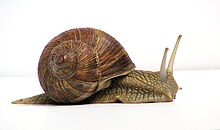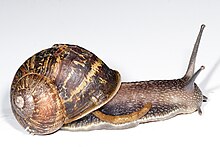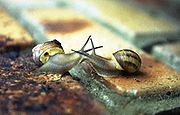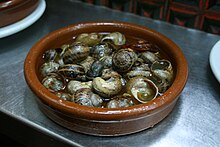Land snail: Difference between revisions
whitespace & alpha list |
|||
| Line 29: | Line 29: | ||
When retracted into their shells, many snails with gills (including many marine, some freshwater and some terrestrial species) are able to protect themselves with a door-like anatomical structure called an ''[[operculum (gastropod)|operculum]]''. (The operculum of some sea snails has a pleasant scent when burned, so it is sometimes used as an [[operculum (incense ingredient)|ingredient]] in [[incense]].) |
When retracted into their shells, many snails with gills (including many marine, some freshwater and some terrestrial species) are able to protect themselves with a door-like anatomical structure called an ''[[operculum (gastropod)|operculum]]''. (The operculum of some sea snails has a pleasant scent when burned, so it is sometimes used as an [[operculum (incense ingredient)|ingredient]] in [[incense]].) |
||
Snails range greatly in size. The largest land snail is the [[Achatina fulica|Giant African Snail]] or Ghana Tiger Snail (''[[Achatina achatina]]''; Family [[Achatinidae]]), which can measure up to 30 cm. ''Pomacea maculata'' (Family [[Ampullariidae]]), or Giant [[Apple snail|Apple Snail]] is the largest freshwater snail, with a diameter of up to 15 cm and a [[mass]] of over 600 g. The biggest of all snails is ''[[Syrinx aruanus]]'', an [[Australia]]n marine species which can grow up to 77.2 cm (30 inches) in length<ref>[http://www.conchologistsofamerica.org/faq/#q6 Conchologists of America FAQ no. 6]</ref> and 18 kg (40 lbs) in weight.<ref>[http://www.g-kexoticfarms.com/funanimalfacts.html Fun Animal Facts]</ref> |
Snails range greatly in size (of course that is still small because its a snail). The largest land snail is the [[Achatina fulica|Giant African Snail]] or Ghana Tiger Snail (''[[Achatina achatina]]''; Family [[Achatinidae]]), which can measure up to 30 cm. ''Pomacea maculata'' (Family [[Ampullariidae]]), or Giant [[Apple snail|Apple Snail]] is the largest freshwater snail, with a diameter of up to 15 cm and a [[mass]] of over 600 g. The biggest of all snails is ''[[Syrinx aruanus]]'', an [[Australia]]n marine species which can grow up to 77.2 cm (30 inches) in length<ref>[http://www.conchologistsofamerica.org/faq/#q6 Conchologists of America FAQ no. 6]</ref> and 18 kg (40 lbs) in weight.<ref>[http://www.g-kexoticfarms.com/funanimalfacts.html Fun Animal Facts]</ref> |
||
Most snails bear one or two pairs of [[tentacle]]s on their heads. In most [[Stylommatophora|land snails]] the eyes are carried on the first (upper) set of tentacles (called [[ommatophores]] or more informally 'eye stalks') which are usually roughly 75% of the width of the eyes. The second (lower) set of tentacles act as [[olfaction|olfactory]] organs. Both sets of tentacles are retractable in [[Stylommatophora|land snails]]. The eyes of most marine and freshwater snails are found at the base of the first set of tentacles. |
Most snails bear one or two pairs of [[tentacle]]s on their heads. In most [[Stylommatophora|land snails]] the eyes are carried on the first (upper) set of tentacles (called [[ommatophores]] or more informally 'eye stalks') which are usually roughly 75% of the width of the eyes. The second (lower) set of tentacles act as [[olfaction|olfactory]] organs. Both sets of tentacles are retractable in [[Stylommatophora|land snails]]. The eyes of most marine and freshwater snails are found at the base of the first set of tentacles. |
||
Revision as of 03:19, 29 July 2010


A land snail is any of the many species of snail that live on land, as opposed to those that live in saltwater and those that live in freshwater. Land snails are terrestrial gastropod mollusks that have shells.
Biology
Physical characteristics


Most snails move by gliding along on their muscular foot, which is lubricated with mucus and covered with epithelial cilia[1]. This motion is powered by succeeding waves of muscular contractions that move down the ventral of the foot. This muscular action is clearly visible when a snail is crawling on the glass of a window or aquarium. Snails move at a proverbially low speed (1 mm/s is a typical speed for adult Helix lucorum[2]). They produce mucus to aid locomotion by reducing friction, and the mucus also helps reduce the snail's risk of mechanical injury from sharp objects. This means that they can crawl along sharp objects like a straight razor and survive without injury.[3] Snails also have a mantle, a specialized layer of tissue which covers all of the internal organs as they are grouped together in the visceral mass, and the mantle also extends outward in flaps, which reach to the edge of the shell and in some cases can cover the shell, and which are partially retractable. The mantle is attached to the shell and creates it by secretion.
Most mollusks, including snails, have a shell which they have from the larval stage and which grows with them in size by the process of secreting calcium carbonate. Because of this, mollusks need calcium in their diet and environment to produce a strong shell. A lack of calcium, or low pH in their surroundings, can result in thin, cracked, or perforated shells. Usually a snail can repair damage to its shell over time if its living conditions improve, but severe damage can be fatal.
When retracted into their shells, many snails with gills (including many marine, some freshwater and some terrestrial species) are able to protect themselves with a door-like anatomical structure called an operculum. (The operculum of some sea snails has a pleasant scent when burned, so it is sometimes used as an ingredient in incense.)
Snails range greatly in size (of course that is still small because its a snail). The largest land snail is the Giant African Snail or Ghana Tiger Snail (Achatina achatina; Family Achatinidae), which can measure up to 30 cm. Pomacea maculata (Family Ampullariidae), or Giant Apple Snail is the largest freshwater snail, with a diameter of up to 15 cm and a mass of over 600 g. The biggest of all snails is Syrinx aruanus, an Australian marine species which can grow up to 77.2 cm (30 inches) in length[4] and 18 kg (40 lbs) in weight.[5]
Most snails bear one or two pairs of tentacles on their heads. In most land snails the eyes are carried on the first (upper) set of tentacles (called ommatophores or more informally 'eye stalks') which are usually roughly 75% of the width of the eyes. The second (lower) set of tentacles act as olfactory organs. Both sets of tentacles are retractable in land snails. The eyes of most marine and freshwater snails are found at the base of the first set of tentacles.
Internal anatomy


A snail breaks up its food using the radula, which is a chitinous structure containing microscopic hooks called cuticulae. With this the snail scrapes at food, which is then transferred to the digestive tract. This is why, in a quiet setting, a large land snail can be heard 'crunching' its food: the radula is tearing away at what it is eating.
The cerebral ganglia of the snail form a primitive brain divided into four sections. This structure is very much simpler than the brains of mammals, reptiles and birds, but nonetheless, snails are capable of associative learning.[6]
Growth of the shell
As the snail grows, so does its calcium carbonate shell. The shell grows additively, by the addition of new calcium carbonate, which is secreted by glands located in the snail's mantle. The new material is added to the edge of the shell aperture (the opening of the shell). Therefore the center of the shell's spiral was made when the snail was younger, and the outer part when the snail was older. When the snail reaches full adult size, it may build a thickened lip around the shell aperture. At this point the snail stops growing, and begins reproducing.
A snail's shell forms a logarithmic spiral. Most snail shells are right-handed, meaning that if the shell is held with the apex (the tip, or the juvenile whorls) pointing towards the observer, the spiral proceeds in a clockwise direction from the apex to the opening.

Hibernation and estivation
Some snails hibernate during the winter (typically October through April in the Northern Hemisphere). They may also estivate in the summer in drought conditions. If snails are not able to hibernate due to things like global warming, the snail can die or its species may even go extinct like the Aldabra banded snail.To stay moist during hibernation, a snail seals its shell opening with a dry layer of mucus called an epiphragm.
Some freshwater snails such as apple snails have gills and a "door" or operculum to close the shell when they withdraw. This structure functions as protection from predators as well as protecting the soft tissues from desiccation when an aquatic habitat dries out temporarily.
Reproduction


All land snails are hermaphrodites, producing both spermatozoa and ova. Some freshwater snails, such as apple snails, and marine species, such as periwinkles, have separate sexes; they are male and female. The age of sexual maturity is variable depending on species of snail, ranging from as little as 6 weeks [7] to 5 years [8]. Adverse environmental conditions may delay the onset of sexual maturity in some snails [9].
Prior to reproduction, most land snails perform a ritual courtship before mating. This may last anywhere between two and twelve hours.
Prolific breeders, pulmonate land snails inseminate each other in pairs to internally fertilize their ova via a reproductive opening on one side of the body, near the front, through which the outer reproductive organs are extruded so that exchange of sperm can take place. Fertilization then occurs and the eggs develop. Each brood may consist of up to 100 eggs.
Garden snails bury their eggs in shallow topsoil primarily while the weather is warm and damp, usually 5 to 10 cm down, digging with their foot. Egg sizes differ between species, from a 3 mm diameter in the grove snail to a 6 mm diameter in the Giant African Land Snail. After 2 to 4 weeks of favorable weather, these eggs hatch and the young emerge. Snails may lay eggs as often as once a month.
The snail's shell develops while it is still an embryo; it is, however, very weak, and needs an immediate supply of calcium. Newly hatched snails obtain this by eating the egg from which they hatched. The cannibalization by baby snails of other eggs, even unhatched ones, has been recorded. Promptly after they are finished ingesting their egg casings, they crawl upwards through the small tunnel in order to digest the egg. At this stage, the young are almost completely transparent and colorless. Their shell is usually slightly smaller than the egg they hatched from, but their length when out of their shell is slightly greater than the egg diameter. After a few weeks, the snails will begin to show their first tinge of color, usually slightly blue, before they turn their adult color. Roughly three months after they have hatched, they will look like miniature versions of their mature kin. They will continue to grow, usually for two to three years, until they reach adult size, although there have been confirmed recordings of snails growing amazingly fast - becoming even bigger than their parents in little more than a month.[citation needed] Irrespective of their rate of growth, however, it will still take at least 1 year before they are sexually mature.[10]
There have been hybridizations of snails; although these do not occur commonly in the wild, in captivity they can be coaxed into doing so.
Parthenogenesis has also been noted in certain species.[11][12]
Freshwater pond snails do not lay their eggs in the ground, but instead attach them to something solid, or in some genera they carry the eggs internally until they hatch, a form of vivipary.
Lifespan
The lifespan of snails varies from species to species. In the wild, Achatinidae snails live around 5 to 7 years and Helix snails live about 2 to 3 years. Most deaths are due to predators or parasites. In captivity, their lifespan is much longer, ranging from 10 to 15 years for most species. On occasions, snails have lived beyond this lifespan, up to 30 years.[13]
Diet
In the wild, snails eat a variety of different foods. Terrestrial snails are usually herbivorous, however in some places there are localised species that are carnivores or omnivores. Their diet can include leaves, stems, soft bark, fruit, vegetables and algae. Some species can cause damage to agricultural crops and garden plants, and are therefore often regarded as pests. Aquatic snails eat other varieties of food such as plankton, algae, plants, and other microscopic organisms that live underwater or in the sand on the shoreline.
Predators
Land snails have many natural predators, including members of all major vertebrate groups, decollate snails, ground beetles, leeches, and even the predatory caterpillar Hyposmocoma molluscivora. The Botia family of freshwater fish also feed on freshwater snails by sucking them out of their shells.
In the pulmonate marsh snail, Succinea putris, there is a parasitic flatworm, Leucochloridium paradoxum, which prevents the snail from retracting its enlarged and parasitized eye stalk, which thus makes the snail much more likely to be eaten by a bird, the final host of the worm.
Humans also pose great dangers to snails in the wild. Pollution and habitat destruction have caused the extinction of a number of snail species in recent years.[14][15] To protect themselves against predators, they usually hide in their shell or bury themselves.
Snails as human food
This section needs additional citations for verification. (March 2009) |

Snails have been eaten for thousands of years, going back at least as far as the Pleistocene. Archaeological evidence of snail consumption is especially abundant in Capsian sites in North Africa, but is also found throughout the Mediterranean region in archaeological sites dating between 12,000 and 6,000 years ago.[16][17] Wild-caught land snails that are undercooked can harbor a parasite (Angiostrongylus cantonensis) that may cause a rare kind of meningitis.[18]
Snail eggs, sold as snail caviar, are a specialty food that is growing in popularity in European cuisine.[19]
Europe
Snails are eaten in several European countries, as they were in the past in the Roman Empire. Mainly three species, all from the genus Helix, are ordinarily eaten:
- Helix pomatia, or edible snail, generally prepared in its shell, with parsley butter (size: 40 to 55 mm for an adult weight of 25 to 45 g.; typically found in Burgundy, France; known as l'Escargot de Bourgogne).
- Helix aspersa:
- Helix aspersa also known as the European brown snail, is cooked in many different ways, according to different local traditions (size: 28 to 35 mm for an adult weight of 7 to 15 g.; typically found in the Mediterranean countries of Europe and North Africa and the French Atlantic coast; Helix aspersa aspersa known as le Petit-gris).
- Helix aspersa maxima (size 40 to 45 mm for an average weight of 20 to 30 g.; typically found in North Africa).
Snails are a delicacy in French cuisine, where they are called escargots. In an English-language menu, escargot is generally reserved for snails prepared with traditional French recipes (served in the shell with a garlic and parsley butter). Before preparing snails to eat, the snails should be fasting for three days with only water available. After three days of fasting, the snails should be fed flour and offered water for at least a week. This process is thought to cleanse the snails.

Snails are also popular in Portuguese cuisine where they are called in Portuguese caracóis, and served in cheap snack houses and taverns, usually stewed (with different mixtures of white wine, garlic, piri piri, oregano, coriander or parsley, and sometimes chouriço). Bigger varieties, called caracoletas, are generally grilled and served with a butter sauce, but other dishes also exist such as feijoada de caracóis. Overall, Portugal consumes about 4,000 tonnes of snails each year.[20]


Traditional Spanish cuisine also uses snails ("caracoles" in Spanish; "caragols" or "cargols" in Catalonian), consuming several species such as Cryptomphalus aspersus, Otala punctata, Helix pisana, or Helix alonensis among others. Snails are very popular in Andalusia, Levante and Catalonia. There are even snails celebration, as the "Aplec del cargol", which takes place in Lleida each May and draws more than 200,000 visitors from abroad. Small to medium-size varieties are usually cooked in several spicy sauces or even in soups and eaten as appetizer. The bigger ones may be reserved for other more elaborated dishes, such as the "arroz con conejo y caracoles" (a paella-style rice with snails and rabbit meat, from the inner regions of south-eastern Spain), "cabrillas" (snails in spicy tomato sauce, typical from western Andalusia) or the Catalonian caragols à la llauna (grilled inside their own shells and then eaten after dipping them in garlic mayonnaise) and à la gormanda (boiled in tomato and onion sauce).
In Greece, snails are especially popular in the island of Crete, but are also eaten in many parts of the country and can even be found in supermarkets, sometimes placed alive near partly refrigerated vegetables. In this regard, snails are one of the few live organisms sold at supermarkets as food. They are eaten either boiled with vinegar added, or sometimes cooked alive in a casserole with tomato, potatoes and squashes. Limpets and sea snails also find their way to the Greek table around the country. Another snail cooking method is the Kohli Bourbouristi (κοχλιοί μπου(ρ)μπουριστοί)[21] a traditional Cretan dish, which consists of fried snails in olive oil with salt, vinegar and rosemary.
They feature often in Cyprus taverna menus, under the mezes.[22]
In Sicily, snails (or babbaluci as they are commonly called in Sicilian) are a very popular dish as well. They are usually boiled with salt first, then served with tomato sauce or bare with oil, garlic and parsley. Snails are similarly appreciated in other Italian regions, such as Sardinia.
Snails (or bebbux as they are called in Maltese) are a dish on the Mediterranean island of Malta, generally prepared and served in the Sicilian manner.
In southwestern Germany there is a regional specialty of soup with snails and herbs, called "Black Forest Snail Chowder" (Badener Schneckensuepple).
Heliciculture is the farming of snails. "They are protected in the wild almost everywhere (at least, the Roman Snail must not be collected any more), but the Roman Snail and the Garden Snail (Cornu aspersum) especially are cultivated on snail farms."[13]
Although there is not usually considered to be a tradition of snail eating in Britain, common garden snails Helix aspersa were eaten in the Southwick area of Sunderland in North East England. They were collected from quarries and along the stone walls of railway embankments during the winter when the snails were hibernating and had voided the contents of their guts. Gibson writes that this tradition was introduced in the 19th Century by French immigrant glass workers.[23] "Snail suppers" were a feature of local pubs and Southwick working men were collecting and eating snails as late as the 1970s, though the tradition may now have died out.
Africa
Achatina fulica, the giant east african snail, is canned and sliced and sold to consumers as escargot.[citation needed]
In parts of West Africa, specifically Ghana, snails are served as a delicacy. [1] Achatina achatina, Ghana tiger snails, are also known as some of the largest snails in the world.
In North Morocco, small snails are eaten as snacks in spicy soup. The recipe is identical to this prepared in Andalusia (South Spain), showing the close cultural relationship between both kinds of cuisine.
Central America
Archaeological investigations in Guatemala have revealed that the diet of the Maya of the Classic Period (AD 250-900) included freshwater snails.[24]
See also
References
- ^ "integument (mollusks)."Encyclopædia Britannica. 2009. Encyclopædia Britannica 2006 Ultimate Reference Suite DVD
- ^ G.A. Pavlova (1 May 2001). "Effects of serotonin, dopamine and ergometrine on locomotion in the pulmonate mollusc Helix lucorum" (pdf). Journal of Experimental Biology. 204 (9): 1625–1633. PMID 11398751. Retrieved 2006-05-24.
- ^ "Snails for kids and teachers : All about snails". Kiddyhouse.com : The resource center for kids and teachers. Retrieved 2008-08-08.
- ^ Conchologists of America FAQ no. 6
- ^ Fun Animal Facts
- ^ Christie Sahley, Alan Gelperin, and Jerry W. Rudy (January 1, 1982). "One-Trial Associative Learning Modifies Food Odor Preferences of a Terrestrial Mollusc". Proceedings of the National Academy of Sciences. 78 (1). National Academy of Sciences: 640–642. doi:10.1073/pnas.78.1.640. PMID 16592960.
{{cite journal}}: CS1 maint: multiple names: authors list (link) - ^ http://digital.library.adelaide.edu.au/dspace/handle/2440/37983
- ^ http://www.columbia.edu/itc/cerc/danoff-burg/invasion_bio/inv_spp_summ/Euglandina_rosea.html
- ^ http://www.jstage.jst.go.jp/article/aez/37/1/37_199/_article/-char/en
- ^ Snails
- ^ www.blackwell-synergy.com/doi/pdf/10.1111/j.1420-9101.2004.00791.x
- ^ http://links.jstor.org/sici?sici=0014-3820(199208)46%3A4%3C907%3APIAFSR%3E2.0.CO%3B2-F
- ^ a b The Roman snail or escargot (Helix pomatia)
- ^ Centre for Biological Diversity: snail extinction update
- ^ Hawaii's Extinct Species – Snails
- ^ Prehistoric edible land snails in the circum-Mediterranean: the archaeological evidence., D. Lubell. In J-J. Brugal & J. Desse (eds.), Petits Animaux et Sociétés Humaines. Du Complément Alimentaire Aux Ressources Utilitaires. XXIVe rencontres internationales d'archéologie et d'histoire d'Antibes, pp. 77-98. Antibes: Éditions APDCA.]
- ^ Are land snails a signature for the Mesolithic-Neolithic transition? In, M. Budja (ed.), Neolithic Studies 11. Documenta Praehistorica XXXI: 1-24. D. Lubell.
- ^ Division of Parasitic Diseases - Angiostrongylus Infection Fact Sheet
- ^ Snail caviar! The new gourmet frontier
- ^ According to the article Comemos três a quatro mil toneladas de caracóis por ano, by Joana Ferreira da Costa, in the 26.08.2007 edition (n.6358) of the daily newspaper Público.
- ^ Popping Fried Snails - Kohli Bourbouristi Recipe
- ^ http://www.worldisround.com/articles/164352/photo25.html
- ^ Peter Gibson (1999). The People's History: Southwick.
- ^ Template:Es icon Foias, Antonia E. (2000). "Entre la política y economía: Resultados preliminares de las primeras temporadas del Proyecto Arqueológico Motul de San José" (PDF online publication). XIII Simposio de Investigaciones Arqueológicas en Guatemala, 1999 (edited by J.P. Laporte, H. Escobedo, B. Arroyo and A.C. de Suasnávar). Museo Nacional de Arqueología y Etnología, Guatemala: 771–799. Retrieved 2009-03-01.
{{cite journal}}: templatestyles stripmarker in|author=at position 1 (help)CS1 maint: numeric names: authors list (link), page 777.
